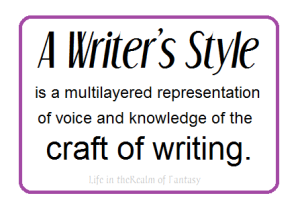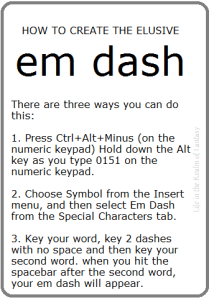 A little power is a dangerous thing, and certain punctuation has power.
A little power is a dangerous thing, and certain punctuation has power.
Exclamation points!
Em dashes—
Ellipses…
These are all wonderful, fun things to play with, but making too free with the power punctuation makes the narrative too breathless, or in the case of ellipses, too slow. When prose is well written, it conveys the excitement of the moment without force. A good author doesn’t resort to creating excitement with the overuse of exclamation points as this makes the narrative breathless. It tells the reader what to think, rather than showing them a scene that is exciting.
When I am laying down the first draft, I am just as guilty of filling the manuscript with exclamations, em dashes, and ellipses. I am in a rush to get the ideas down on paper, so in some places, this is a subconscious shorthand for the second draft, which is where I take those telling scenes and show them.
I do a global search for exclamation points, ellipses, and em dashes. At each one, I examine the scene. Nine times out of ten, I change the power punctuation to a period, or I find the em dash or ellipsis was not needed.
Exclamation points, em dashes, and ellipses are like speech tags. They are necessary, but simplicity is the key to making them unobtrusive. Generally, dialogue worded powerfully, along with the way you visualize and then show the attitude of the characters and their situation will serve to convey the emotions.
When it’s done right, you will only need one or two morsels of power punctuation, and the punctuation you use won’t be a needle in the eye of the reader. The common, garden-variety period or comma will usually serve the situation well, and won’t throw the reader out of the book.
All punctuation has its place and should be used appropriately. Exclamation points, em dashes, and ellipses should be used, but only at important points. For the most part, the way you have set the scene combined with the dialogue itself will convey the tension without your having to sprinkle the narrative with power punctuation.
I suggest you do a global search and change most of them to a period.
But what about !? I only recently learned that these are called “interrobangs.” Comic books frequently employ interrobangs, generally because the authors are limited on space for narrative and use creative punctuation as a shorthand. They do this as a way of telling the story.
It’s your narrative, so of course, you will do as you see fit. However, the exclamation point before a question mark is not accepted punctuation in literature intended for adults, so don’t be surprised if you receive negative feedback in reviews. Interrobangs are a writing habit professional writers will avoid if they want to be taken seriously.
Peppering the narrative with exclamation points and interrobangs is a form of telling the reader “this is exciting”, as opposed to showing the excitement. We want to immerse the reader, not blow them out of the manuscript. A great resource for ideas on how to convey strong emotions without telling the reader what the character is feeling is The Emotion Thesaurus: A Writer’s Guide to Character Expression by Angela Ackerman and Becca Puglisi.
All sentences should have only one punctuation mark to signify the end. “Ahah!” you say. “What about the ellipsis?” When the ellipsis falls at the end of the sentence, it should be three dots followed by the required punctuation.
- If the ellipsis falls at the end of a sentence in dialogue, use a comma at the end of it followed by a speech tag. “But, my dog…,” Annie said, her brow furrowed.
- If no speech tag is used, employ a period, question mark, etc. “But, my dog….” Annie’s brow furrowed.
This is because the ellipsis or em dash at the end of a sentence symbolize unspoken words, trailing off. They are not considered punctuation.
This is what the Chicago Manual of Style says:
Use an ellipsis for any omitted word, phrase, line, or paragraph from within a quoted passage. There are two commonly used methods of using ellipsis: one uses three dots for any omission, while the second makes a distinction between omissions within a sentence (using three dots: . . .) and omissions between sentences (using a period and a space followed by three dots: . …). An ellipsis at the end of a sentence with no sentence following should be followed by a period (for a total of four dots).
Once again, I emphasize that we use the Chicago Manual of Style if we are writing fiction and intend to publish it. The Chicago Manual of Style is written specifically for writers, editors, and publishers and is the publishing industry standard. All the editors at the major publishing houses own and refer to this book when they have questions.
What is the best style guide for writing technical user manuals?
- Chicago Manual of Style (The Chicago Manual of Style Online)
- Microsoft Style for Technical Publication (Microsoft® Manual of Style, Fourth Edition)
Are you writing for a newspaper? AP style was developed for expediency in the newspaper industry and is not suitable for novels or for business correspondence, no matter how strenuously journalism majors try to push it forward. If you are using AP style, you are writing for the newspaper, not for literature. These are two widely different mediums with radically different requirements.
For business correspondence, you want to use the Gregg Reference Manual.
If you develop a passion for words and ways in which we bend them, as I have done, you could soon find your bookshelf bowing under the weight of your reference books. Writing is not a one-size-fits-all kind of occupation. There is no one style guide that will fit every purpose. Each essay and book may be meant for a different reader, and each should be written with the style that meets the expectations of the intended readers.
However, some things are universal:
 Exclamation points must be used sparingly.
Exclamation points must be used sparingly.
Ellipses symbolize omitted words and are not punctuation, so when the conversation trails off, you must add an ending punctuation. My God, I thought. What…?
Em dashes can either set off phrases—like this—or if used at the end of a sentence an em dash can indicate cut off words.
Consider the following quote from A Dog’s Tale by Mark Twain. In this case, you do not add punctuation:
It did seem to me that life was just too lovely to—
It is your task to write the narrative so that it shows the character’s emotions. Their eyes will widen, or their mouth will drop open, or they will stop and stare. When it comes to punctuation, do you tell, or do you show? You make the decision, but I see the interrobang and the overuse of the exclamation point as if they were too much seasoning, strong flavors that can ruin the the taste of the narrative.
Sources and Attributions:
The Chicago Manual of Style (16th ed.), page 639 sections 13.51 – 13.55 The Chicago Manual of Style 16th edition text © 2010 by The University of Chicago.
The Chicago Manual of Style (16th ed.), page 334 Section 6.84 Em dashes to Indicate Sudden Breaks, The Chicago Manual of Style 16th edition text © 2010 by The University of Chicago.
A Dog’s Tale, by Mark Twain. © 1904 Harper & Brothers, via Wikipedia, The Free Encyclopedia, https://en.wikipedia.org/w/index.php?title=A_Dog%27s_Tale&oldid=769178379 (accessed May 16, 2017).








Hi Connie,
Great post. I have a couple of comments and questions for you. The writing course I took said if possible, do not use exclamation points. If you have to, use them sparingly. When I write dialogue and the speaker is interrupted, I use an em dash. Is this acceptable or should I be using an ellipse? The only time I use an ellipse is when I am quoting someone and I do not include the total quote or I exclude a portion. Is using the em dash and the ellipse both acceptable and inter-changeable? Thank you for your assistance.
LikeLiked by 1 person
Hello Chuck – in my opinion the em dash is really good for when a speaker is interrupted. What I think each time I see ellipses in dialogue is that the speaker has either lost his/her train of thought or they are unable to finish the sentence for other reasons. It makes me feel as if they have trailed off, so that is how I use them. When I see them, I assume the author chose to slow the pace of the narrative, because for me, that’s what ellipses do and there are places where that slowing is necessary. Em dashes are useful to impart a sense of suddenness to a broken off sentence. My opinions are just my thoughts, of course. I use em dashes and ellipses, and occasionally, increasingly rarely, an exclamation point.
LikeLiked by 2 people
Thank you.
LikeLiked by 1 person
Reblogged this on Chris The Story Reading Ape's Blog.
LikeLiked by 1 person
Thank you, kind sir ♥
LikeLiked by 1 person
Welcome, Connie 😀
LikeLiked by 1 person
The interrobang is an abomination. I haven’t ever edited a manuscript in which such punctuation is used, but if it does happen, I’ll be tempted to throw the writer across the room (instead of just the manuscript).
A question about ellipses: Do you have any idea what’s up with the ‘truncated ellipses’ (two dots instead of three) that show up all over the place these days? Is some idjit actually TEACHING newbie writers that the number of dots is linked to the length of the pause?
LikeLike
Hello Thomas! No, I think it’s an error that happens when a sentence is cut and either pasted else where or simply removed. When it’s pasted elsewhere that already contains a period it’s easy to overlook the extra one. At least, that is my suspicion, because it happens sometimes that way for me. I do find it aggravating to see this in my manuscript I thought was fairly clean. 😦
LikeLike
Reblogged this on When Angels Fly.
LikeLike
Thank you ♥
LikeLiked by 1 person
Welcome!
LikeLike
Thanks Connie reblogged on http://suzannenewnham.wordpress.com/
LikeLike
Thank you for the reblog 🙂 I’m glad you liked it.
LikeLiked by 1 person
Good article – also tweeted via @SuzanneNewnham
LikeLike
♥♥♥
LikeLike